 |
|
| entry created: Sunday 29 August 2004, 1:08am (NZ time) | |
|
|
| Location: Märjamaa, Estonia |
| Local time: Saturday, 4:15pm |
| Music: |
 I'm now 45 minutes into my 15 hour journey from Moscow back to Tallinn. Lucky I'm even here I guess, since the 6:15pm train left exactly on time, whereas I, however, had only stepped on-board about 20 seconds earlier, after a stressful sprint to the station on already-aching feet. I shall never learn. I'm now 45 minutes into my 15 hour journey from Moscow back to Tallinn. Lucky I'm even here I guess, since the 6:15pm train left exactly on time, whereas I, however, had only stepped on-board about 20 seconds earlier, after a stressful sprint to the station on already-aching feet. I shall never learn.I've just had an unintelligible conversation (mainly in sign language) with the Russian lady sitting behind me. After finally being translated for me, I now have a bottle of vodka stuffed into my bag, so that she doesn't exceed the 'two bottles of vodka' limit imposed by border customs. Sure, I'm sweet, but where's my cut? So now, thanks to some bad planning on my part, I sit with no food and no water, looking forward to a night of train hell. But I don't care. I just saw Russia. St. Petersburg - what a majestic, grand old city. It felt a little like Vilnius (Lithuania) but on a larger scale. Peter the Great began building the city in the 1700s, to be Russia's 'gateway to the west', after he had been exposed to many cultures and ideas whilst travelling extensively throughout Europe. He demanded Russia's aristocrasy to move there, and even went as far as imposing a tax on beards, which he considered to be a part of 'old Russia'. Bizarre. Today, the busy streets are wide and lined with beautiful old buildings, and amongst them cathedrals and palaces are scattered everywhere, as prevalent as the corner store. The huge Winter Palace (residence of every ruler of Russia, starting from Peter III) was stunning during the day, and just as photogenic at night, its green gold and white facade reflected in the Neva River. Referred to as the 'Venice of the North' (it's made up of several large islands, and 200 years ago you had to commute between them by boat) or the 'Paris of the East', St. Petersburg lived up to its name every step of the way. By the end of my time in St. Petersburg, I was invariably taking for granted many of the palacial buildings I passed by - it all became too much to take in. I realised that if you took even the lowliest department store on Nevskiy Prospekt and plopped it into the middle of any New Zealand city (which are no more than 150-years-old), it would be a major attraction; yet here I was walking past these buildings without a second thought. Both days there it rained - hard. But luckily it only lasted about 30 minutes, before making way for blue skies. My only major issue with the place was when it came time to feeding myself. My mastery of the Cyrillic alphabet leaves a lot to be desired, thus deciphering restaurant menus was a real nightmare. (Strangely enough, when ordering, I found myself wanting to use Estonian words to get my message across). I ended up eating at Subway twice. Sampling the local fare was not a priority for me, as I've tried a few Russian dishes in Estonia (and once was enough). Moscow (I still can't believe I've actually visited Moscow!) was altogether a rather different city. For starters it's huge, and it seems that all of Russia's traffic gets channelled through it, as the 12-lane boulevards are jam-packed with (speeding) vehicles of all shapes and sizes. And so many Ladas! (The Russians have done pretty well with architecture, but after seeing such a variety of Russian-made cars, I feel they ought to leave the automotive industry well alone). Moscow's metro (subway) system is really something. Not only is it absolutely teeming with life, it's also probably 150m underground. (Apparently the stations were also designed to double as air raid bunkers.) They're filled with chandeliers and marbled walls, and the occasional ex-Soviet statues of Lenin etc. 44 of these stations have been designated architectural landmarks, and with good reason. Exiting the station on my first day in Moscow, I found myself staring gob-smacked down a road lined with at least 7 cathedral masterpieces, and the red walls of the Kremlin standing triumphantly in the distance. Red Square was just around the corner, lying along the Kremlin's eastern wall. Standing on the massive cobbled area with St. Basil's cathedral's rainbow-coloured onion-shaped domes to the south, the gigantic ex-KGB headquarters and Lubyanka Prison to the north, and Lenin's mausoleum to the west, I think it finally hit me that "wow I'm really here!". In contrast to my Red Square experience, the Kremlin wasn't really as great as I'd hoped. Built on a hill and home to Russia's parliament, it's high stone walls are dotted with tall towers and roughly forms a large triangular compound. From here, Ivan the Terrible and Stalin unleashed all sorts of terror, Lenin undertook the dictatorship of the proletariat, Gorbachev introduced Perestroika, and Yeltsin dreamt of a New Russia. Inside the Kremlin, apart from the palacial houses of parliament, there are about 5 large cathedrals, all steeped in history (royal weddings, coronations, burials etc), and a small-but-pretty garden area. As I experienced first-hand, step onto the cobbled roadway or out of a tourist-designated area and you are greeted with a short sharp whistle blast from one of the many police guards stationed throughout the compound, who, once they have your attention, wave you back into the proper area. Everywhere I went, people were being whistled back into place. It felt more like a game of soccer than a visit to Russia's seat of government. After waiting in line for about 1.5hrs (along with the rest of Moscow), visiting Lenin's tomb and shuffling past his pale and waxy-looking embalmed body was a unique experience. A tiny man, he left a huge impact on his country. Outside, Stalin lies buried along with the rest of his compatriots. Moscow doesn't appear to be lit at night as skilfully as St. Petersburg, but still it was worth returning to the center for an evening stroll and photo shoot. Not once did I feel threatened or unsafe, but my Danish roommate in St. Petersburg had his Visa card snatched out of the ATM machine right in front of him. The young boy had dissappeared into the crowds before he could even give chase. While Russia's youth is thriving (visa theft aside), much of the older generation have paid a heavy price since the introduction of a Capitalist system. Many are living well below the breadline, and seeing the feeble elderly women begging on the steps of every subway station always brought me crashing back down to earth. I've never been able to get used to the begging that seems so rampant throughout Europe. Still another 14 hours to go. My tummy is rumbling angrily, the strong smell of salami (?!) emanating from behind is taunting me, and my feet ache miserably from far too much walking. But it's been a once-in-a-lifetime experience and I'm glad I did it. Still, I'm looking forward to getting back to familiar Estonia... (and then to Sweden on Tuesday). 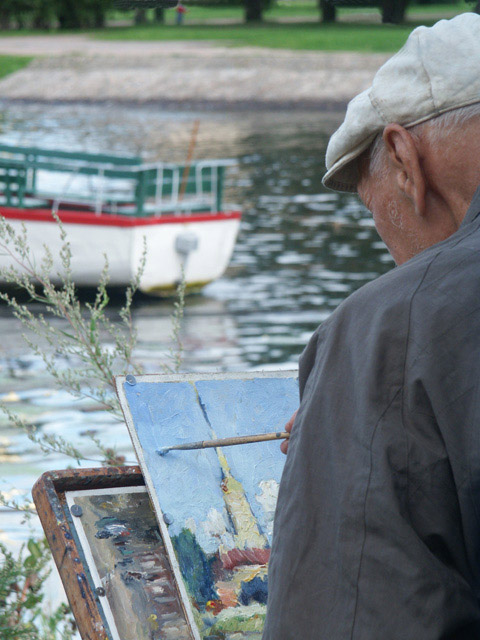 An old man and his impression of the St. Peter and Paul Cathedral, which is inside the Peter and Paul fortress - built by Peter the Great to protect the newly-aquired land from the Swedes. This is one of my most favourite photos of the whole journey.  A cluster of red roofs standing behind the fortress.  The Church of Our Saviour of the Spilt Blood. The site of Alexander II's assasination. What an incredible place.  The huge Kazan Cathedral (1801) standing opposite the cathedral above. No photos I took managed to capture the magnificience of this building. Simply astonishing. 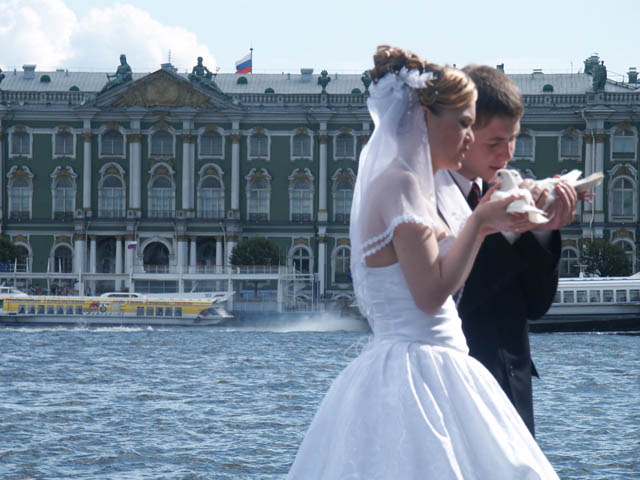 A young Russian couple having their wedding photos taken (and releasing doves) on the Neva River. Notice the Winter Palace in the distance. 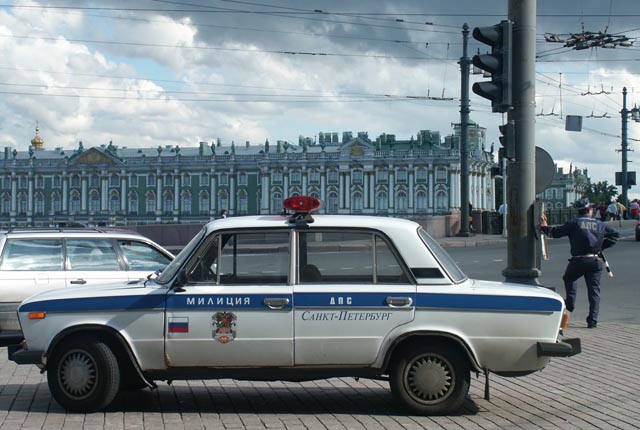 I have no idea how they expect to chase the bad-guys in these things! Again, the Winter Palace in the background. 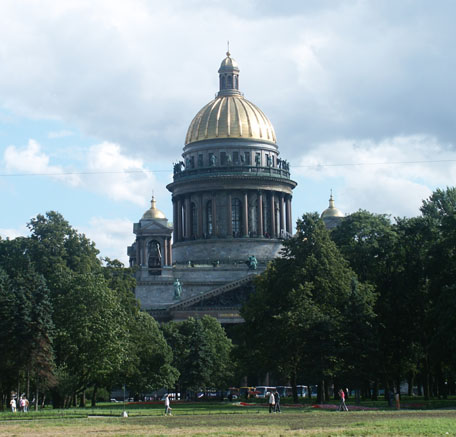 The mighty St. Isaac's cathedral - the world's third-largest domed church. Great views from the top. 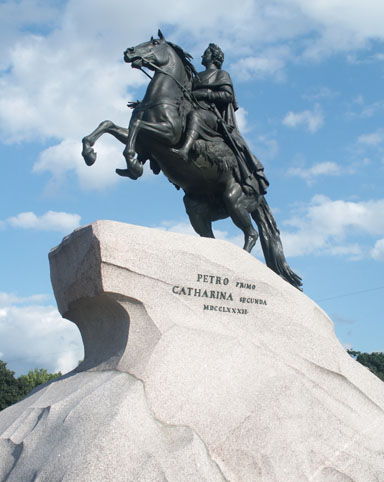 The famous 'Bronze Horseman' statue of Peter the Great. The writing on the side reads "To Peter the Great, from Catherine the Great". 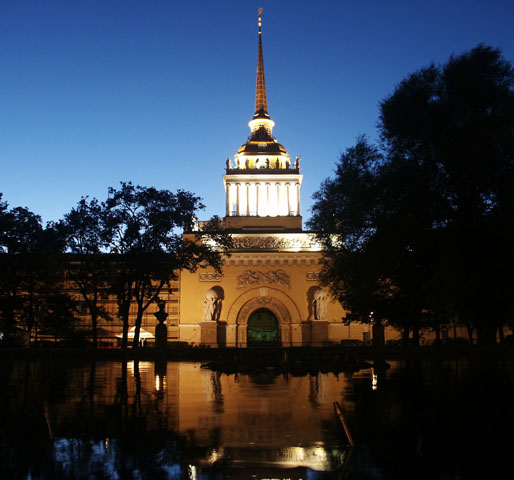 The Admiralty by night, one of St. Petersburg's most famous landmarks.  The cruiser Aurora, which fired the blank shot in 1917 that signalled the working-class to storm the Winter Palace, starting the 1917 revolution. 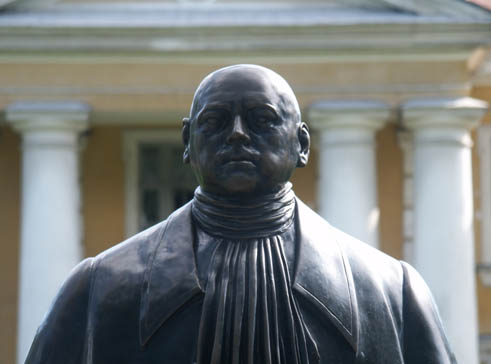 An oddly-proportioned statue of Peter the Great. Rubbing the (now worn) forefinger of his right hand is supposed to bring good luck. 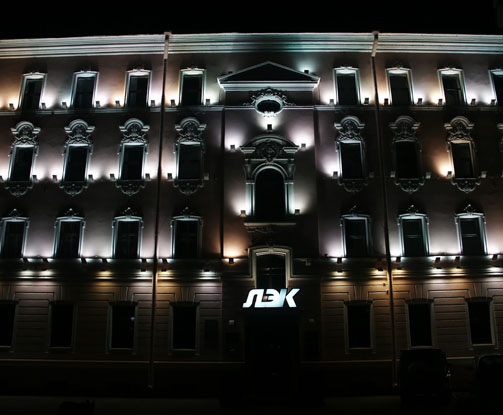 A typical St. Petersburg department store lit up at night.  St. Basil's Cathedral, built in the 1500s, lying at the south end of Red Square. 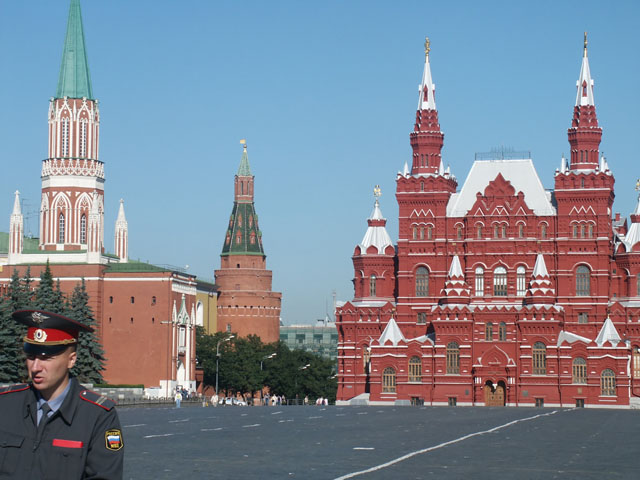 The infamous Red Square. The KGB headquarters on the right, some of the Kremlin's towers on the left. One of the many policeman in the area stands chatting in the corner of the shot. 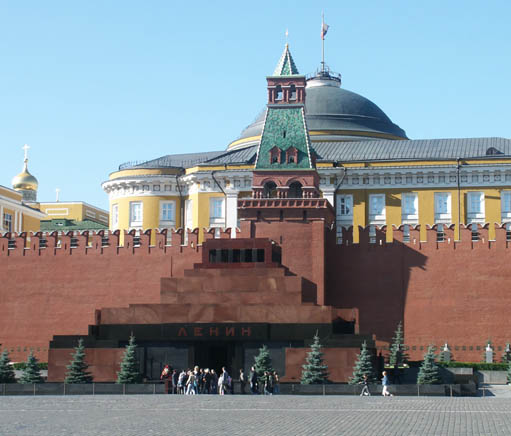 Lenin's mausoleum, against the Kremlin wall. 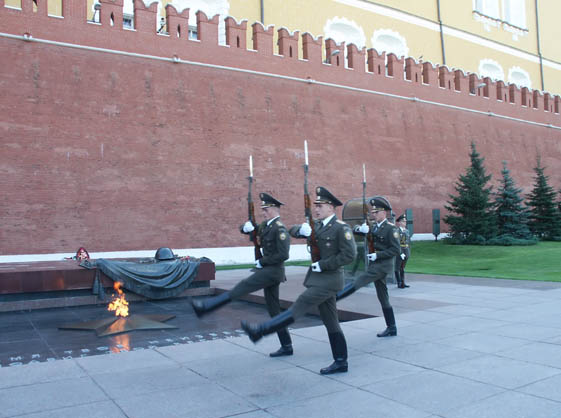 The changing of the guard, at the 'tomb of the unknown soldier'. 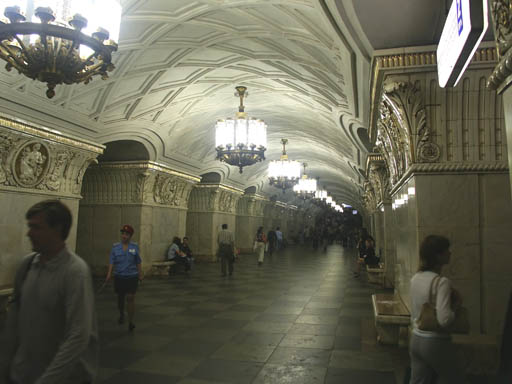 One of Moscow's many fine underground metro stations. Notice the policewoman at the left, walking over to tell me not to take photos. 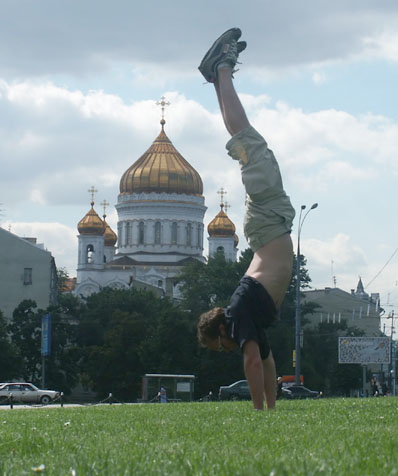 The mighty Cathedral of Christ the Saviour. This self-portrait took a bit of fiddling to finally get right. 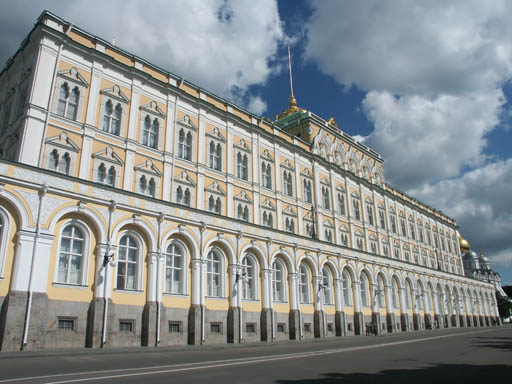 One of the palacial parliament buildings inside the Kremlin (built in the 1100s). 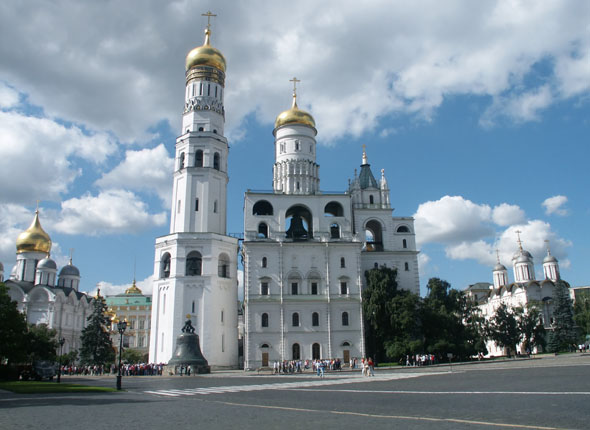 Some of the cathedrals within the Kremlin. Notice the huge 202-tonne bell standing at the foot of the bell tower. This is the world's largest bell, but it cracked before it was ever used. 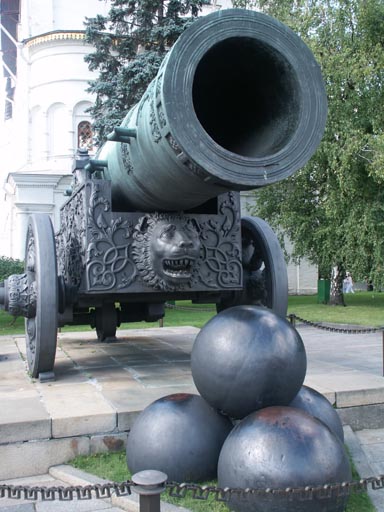 The massive Tsar Cannon (1586), never fired. Each of those cannon-balls are approx. 60cm in diameter.  A monument to Soviet space travel, this 100m tall titanium structure stands above the Cosmonaut Museum. 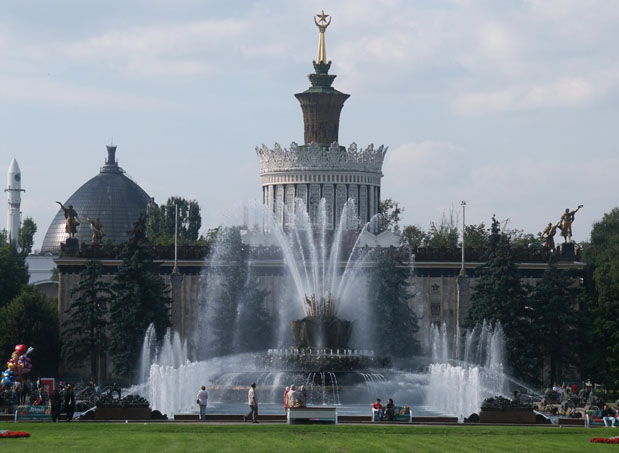 One of the many fountains and large pavilions, making up the VDNKh. No other place sums up the rise and fall of the Soviet dream quite so well as here. 2km long and 1km wide, it is composed of wide pedestrian avenues and massive ornate pavilions, glorifying every aspect of Socialist construction. Amongst it all is a muddle of street-urchins and blow-up amusement rides, ice-cream stands and horse-droppings. The trappings of Capitalism, set against a backdrop of Communist glory. |
< previous next > |